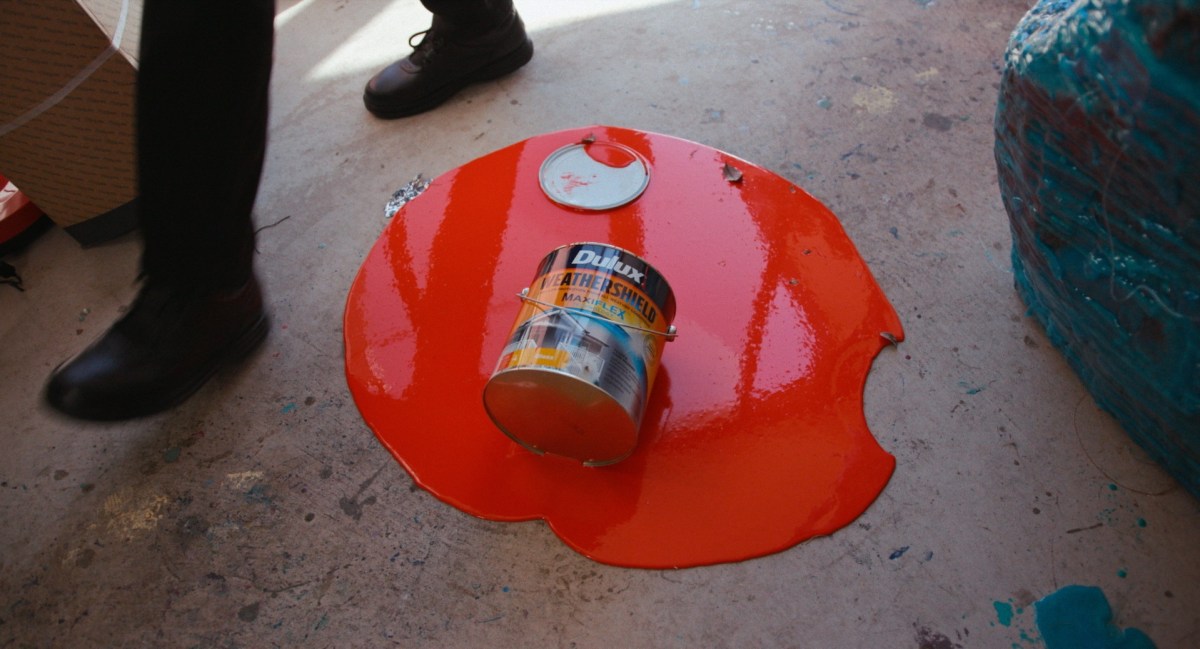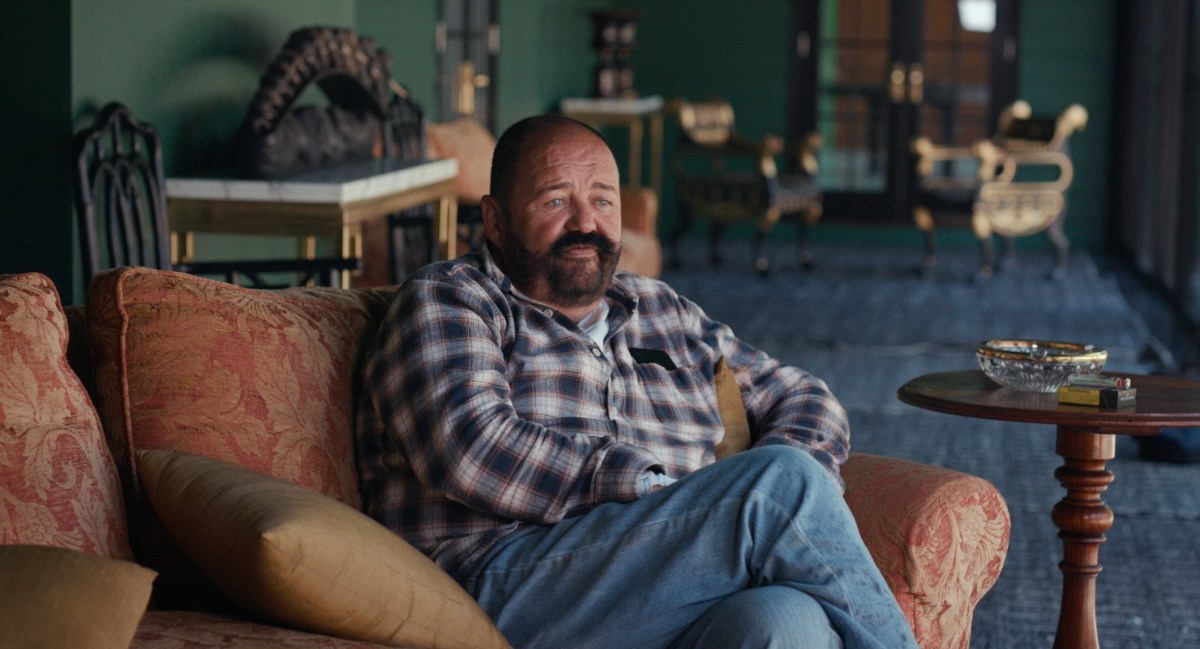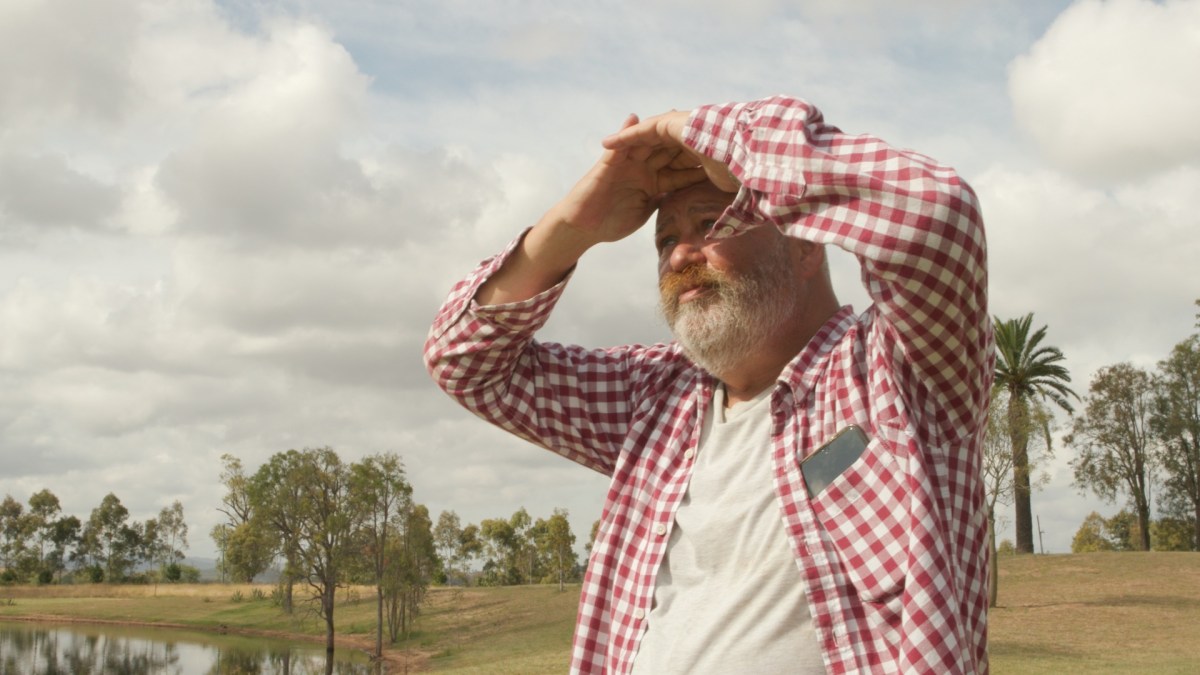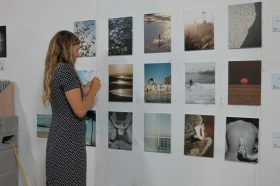As a drone shot slowly pans over a mist-enshrouded mansion somewhat incongruously surrounded by palm trees, you’d be forgiving for thinking that was a cold open for the latest Australian murder mystery. Instead, it’s an enigma of another sort: a portrait of the elusive-in-more-ways-than-one artist Dale Frank.
Ensconced in his Hambledon Hill palace in the Hunter Valley, erected in the 1860s, Frank is a bit of a recluse. Troubled by terrible nerve pain – demonstrated as he aches his way out of bed one morning, his grunts distressing doting ‘big grey puppy’ – he is often irascible, self-medicating with painkillers, whisky and near-constant cigarettes.
Watch the Dale Frank – Nobody’s Sweetie trailer.
Tolerating the presence of his assistants, perma-smiling former soldier and studio manager James Smith plus the less talkative Trevelyan Clay, Frank is a workaholic who bemoans that you can’t pay anyone to show up at weekends.
His large-scale abstract practice involves pouring often bright-hued pigments onto varnished perspex canvases, then raking the swirls into position before asking the lads to lift one edge and studiously observing the drip until issuing a command to stop.
There’s an ASMR appeal in watching him at work that clearly calms Frank, too. He says this tireless focus on his art gives him much-needed structure. ‘If you want to know what hell is, it’s having a two-week holiday,’ he says. ‘I can’t deal with that.’
Dale Frank: reflected ambition
Frank prefers to minimise contact with everyone else. That includes indefatigable filmmaker Jenny Hicks, who laboured tirelessly over this intriguing if occasionally frustrating documentary (no fault of hers) for almost three years through lockdowns.
We occasionally hear her voice, lobbing questions that receive a withering look or a flat-out accusation of being ‘stupid’ from Frank. He can be testy, and he’s not much of a talker.
Chat mostly falls to a roster of art industry talking heads extoling the importance of Frank’s unusual place on the scene, an enfant terrible who has luckily grown old. They include Memo Review editor and curator Amelia Winata, who chortles when noting that Frank is a ‘likeable arsehole’ who would be cancelled if it weren’t for his charm.

Even renowned Sydney gallerist Robyn Oxley cops it. They’ve become good mates in the decades since she staged his first show on returning from flâneuring around Europe in 1982, but that’s no impregnable defence to Frank’s caustic barbs. She takes it because she admires his ambition, a reflection of her own.
It’s both acerbically amusing and a little off-putting to witness Frank’s non-committal shrugs over the pieces Oxley would like to include in a new exhibition. ‘You might get this,’ he huffs as she raises an eyebrow. Then he insists on sending a particularly warty-looking work, to which Oxley wryly responds, ‘We’ll see … We have to sell it’.
Of course, Frank has bills to pay. The ostentatious pile is elaborately outfitted with enormous rugs and his obsession for exotic taxidermy. He bought it as a derelict wreck, requiring significant restoration. No doubt the utility bills are as massive as the acreage outside, which Frank keeps populating with evermore cacti and palms, passionately rescued from development sites, further depleting his exhibition earnings.
Dale Frank: cliffhanger
The few and far-between insights we get into who Frank really mainly involves those professional adventures in the northern hemisphere rather than the closely guarded personal. They include studios in Amsterdam and Milan, showcasing work at the Venice Biennale and a segue in New York as a contemporary of Jean-Michel Basquiat, where Frank made enough of a splash to exhibit in the Guggenheim.
Again, this is no failing on the part of a thorough Hicks, but instead indicative of how tightly Frank holds his cards. There is a fantastic aside on his early success in Australia, with him revealing he would flatter the judges of painting prizes by adopting their style, raking in cash.
When we do join Frank on an unusually emotional visit to the former shack where he was schooled as a kid, there’s a chink in the armour that leads to a deeper understanding.
Secondary school, in particular, was a nightmare, he says, beyond the encouragement of a Scottish art teacher, partly because he stayed silent to avoid a stutter but mostly because, as he puts it, ‘They hadn’t invented autism yet’.

Frank’s neurodivergent diagnosis, late in life, explains a lot to himself, illuminating why he doesn’t have many friends or partners and loathes attending his own openings. There’s much to celebrate in Hicks’ tenacity in sticking with him through thick, thin and stink-eye. Ultimately rewarding the viewer, Frank’s prickliness and solitary nature begin to coalesce, as does his vibrantly swirling art. Just don’t call it playful.
While there’s joy in letting go of the Wikipedia entry exhaustiveness of most documentary portraits, Dale Frank – Nobody’s Sweetie is a touch too long. Still, as Winata suggests, his bumblingly grumpy company is remarkably welcome, despite his best efforts otherwise.
‘Courage is crucial in being an artist … you need courage to get over yourself,’ Franks says in one of the film’s most insightful moments, but his best line and the film’s loudest laugh comes as he responds not-so-sweetly to a question about him being driven:
‘But is it over a cliff?’




